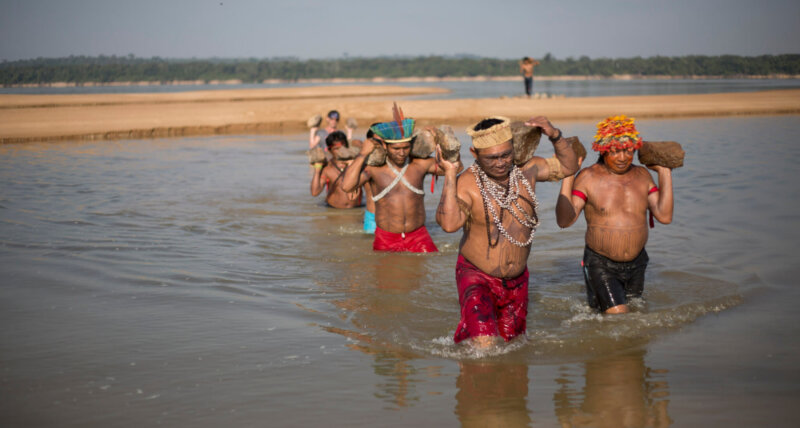Brazil’s Grain Railway will cut right through the Amazon forest. Indigenous people and ecologists are aghast at the plan.
SÃO PAULO, 26 August, 2021 − A controversial 933 km-long line planned to run through the Amazon rainforest, Brazil’s Grain Railway, is one of a package of railway infrastructure projects which the UK-based Climate Bonds Initiative is considering for green certification.
The Ferrogrão, as it is known locally, will run north from Sinop in the heart of the soy- and maize-growing state of Mato Grosso to the port of Miritituba on the Tapajos river, an Amazon tributary.
The chosen route runs close to indigenous areas of the Munduruku, Kayapo and Kayabi peoples, and cuts through the Jamanxim national park, a protected area. To permit this route the Brazilian government introduced a law to reduce the park limits, but this has been suspended by the Supreme Court.
The government plans to auction the proposed railway, which will cost an estimated R$12.7 billion, or almost £2bn, in January 2022. To convince foreign investors that it is environmentally sustainable, in September 2019 it signed a Memorandum of Understanding with Climate Bonds Initiative, a non-profit organisation which awards green certification to sustainable projects.
“They are squeezing us more all the time. Where I live, we now have to go a long way to be able to fish”
If the CBI awards the project its green seal of approval, this will enable the railway’s eventual concessionaire to access funding via green bonds on the international market, now worth an estimated US$1tn. A CBI spokesperson said it had not yet evaluated the certification request of the financial operations for the Ferrograõ’s construction.
Brazil’s infrastructure minister, Tarcisio Gomes de Freitas, explained: “If I’m going to build a railway in the Amazon, I need to transmit security to investors, principally in terms of image. We want to be state-of-the-art in green structuring, environmental governance, monitoring of processes, recovery of degraded areas and crossings for wildlife.”
Freitas says the railway will remove one million tons of CO2 from the atmosphere by providing a cheaper alternative to diesel-fuelled lorry traffic, reducing it by 90% on the existing road connection between Mato Grosso and Miritituba, known as the BR163 highway. Without the railway, the heavily used road, which runs through once dense forest, now extensively cleared, would have to be duplicated.
His Ministry’s site informs users that a “green barrier” will be created by tree planting along the railway route, to hold back the encroachment of farming land.
Exporters will benefit
But the idea that this “ecological barrier” will prevent invasions, especially since the Bolsonaro government has been steadily weakening environmental law enforcement in the Amazon, is strongly disputed by the indigenous peoples affected, who argue they have not been properly consulted about the route, as they have a right to be under Convention 169 of the International Labour Organisation, of which Brazil is a signatory.
Munduruku leader Alessandra says the railway will accelerate the growth of more soy farms and urbanisation: “They are squeezing us more all the time. Where I live, we now have to go a long way to be able to fish.”
Indigenous leaders say they are not against the project per se, but against the way it is being executed, without consultation, violating their right to be heard. They and environmental NGOs dispute the idea that the railway will be ecologically sustainable, claiming that instead it will cause more deforestation, more clearings, deposits of waste, the suppression of vegetation, and the damming of streams.
Those who stand to benefit from the Grain Railway are the large international agribusiness companies who export to China and Europe, who will gain a cheaper route to the international ports on the Amazon river. At the moment 70% of Mato Grosso’s grain harvest is trucked 2000 kms south to ports like Santos.
More destruction ahead
The newly formed Forests and Finance Coalition, an international alliance of almost 50 groups, has just sent a letter to 80 Brazilian and overseas financial institutions, warning them of the risks of investing in Brazil when the national congress is debating laws which could bring irreversible consequences to critical ecosystems like the Amazon, the Pantanal and the Cerrado, and to the rights of indigenous peoples.
Record levels of deforestation and fires are destroying huge swathes of these biomes, aided by a major drought, said to be the worst in 90 years. Rivers are drying up, reservoirs are emptying and fires are raging all over Brazil. If the Grain Railway goes ahead it will inevitably lead to further rainforest destruction.
For the government of Jair Bolsonaro, which has cut funding for environmental protection, dismantled environmental agencies and encouraged the invasion of indigenous and protected areas, to gain the backing of a reputable organisation like Climate Bonds Initiative is a major asset.
For Climate Bonds Initiative, which says it wants to “place Brazil at the centre of the international market to access global capital flows from international investors who are actively looking for good financial products with climate and environmental credentials”, the advantage of linking itself to Brazil’s Grain Railway and to a government with such an openly anti-environment agenda is not clear. − Climate News Network
Main Image: The Munduruku are one group of indigenous Brazilian people unhappy about the prospect of the Grain Railway. Image: By Greenpeace Brasil, via Wikimedia Commons

